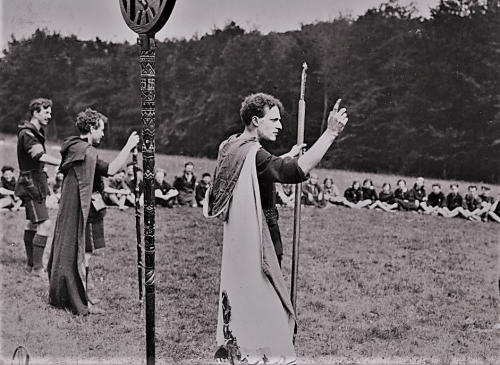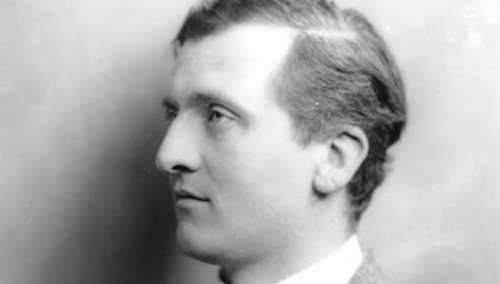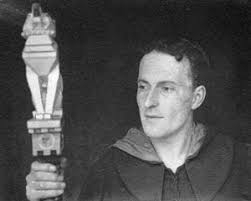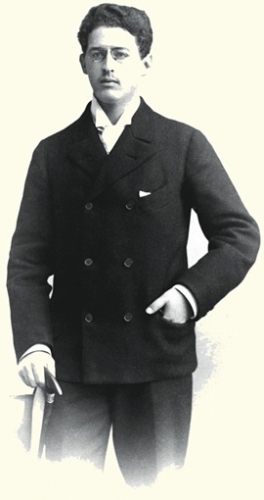jeudi, 10 septembre 2020
“Conservative Revolution” in England—a Sketch

“Conservative Revolution” in England—a Sketch
Fergus Cullen
Ex: https://ferguscullen.blogspot.com
“Conservative Revolution” is a phrase unfamiliar to English politics (as self-identification) or to English scholarship (as well-defined category in the history of political thought).
C.R. in Germany originated as a self-identification (Dietz [b], n. 33 to chap. 1, pp. 215–6) tied up in a self-perception of “German uniqueness” (Sonderweg) (Mohler [b], part 2). That C.R. in Germany is as disputed—from without, in scholarship—as the nation’s “special path” (Klemperer) is a sign of the category’s potency.
Since C.R., rather than a narrowly- and contingently-delimited movement or ideology, is an “attitude” (Mohler [b], p. 229)—a setting oneself against “the Ideas of 1789” on the one hand, and the timidity of mere conservatism on the other—it ought to obtain, in potency if not in act, beyond Germany’s borders.
Dugin explores C.R. in Russia; Veneziani in Italy. Mohler (a) makes some suggestions re. France.
The possibility of C.R. in England was suggested first by Hoeres, then by Dietz (a). Hoeres suggests T. E. Hulme as a figure significantly analogous to German Conservative Revolutionists. Dietz (a) suggests that “neoconservative” Conservative Party circles around Douglas Jerrold and Charles Petrie might constitute an analogue to the Jungkonservativen (see Mohler [b], part 5.2).

T. E. Hulme
Dietz revises his position slightly in (b), detailing “Neo-Tory” goings-on in and around the Conservative Party between the Wars. “Neo-Toryism,” in Dietz’s outline, is regrettably unknown by English politics (as self-identification) and scholarship (as well-defined and potent category). His analogies are worth developing; but he leaves valid analogies unmade. I’ll just sketch both here.
Mohler’s taxonomy (b, part 5):
(1) Young Conservatives;
(2) national-revolutionaries; and the
(3) folkish,
(4) “leaguish” and
(5) peasant movements.
English analogues:
(1*) Neo-Tories, sensu lato;
(2*) (rather lacking) fascists, and fascist-adjacent (Independent) Labour elements;
(3*) e.g., the English Mistery and Array;
(4*) e.g., the British Fascisti, and the Kibbo Kift;
(5*) e.g., Rolf Gardiner, H. J. Massingham, the Soil Association, etc.

Within 1* one can distinguish those more strictly stuck to the Party (Neo-Tories) from more independent minds like the Hulme–Storer circle (influenced by Maurras, Lasserre and the Action Française), the Eliot circle (influenced by the A.F. and by Nationalist Spain), and the Nietzscheans Anthony M. Ludovici, J. M. Kennedy and George Pitt-Rivers. (In his absolute elevation from democratic politics, the latter three’s mentor Oscar Levy can at most be considered an outer limit of 1*. Another limit might be the “die-hard” peers—e.g., Willoughby de Broke—and their associates—e.g., Arthur Boutwood.) The proximity of 1 to 1* went so far as direct collaboration: e.g., Wilhelm Stapel’s contribution to the English Review (Dietz [b], p. 99).
Tories who went beyond sympathy to fascist collaboration or identification mark 1*’s shading into 2*. Mohler, approaching C.R. from within, and maintaining associations with post-War “mere conservatism,” must discount National Socialism from the C.R.’s ranks; though scholarship must feel free to count such defectors from (Independent) Labour to fascism as Oswald Mosley and John Beckett among 2*. Perhaps a Social Crediter like Ezra Pound might designate a limit?
 In which case, with John Hargrave (photo), of the Kibbo Kift, and then the Green Shirt Movement for Social Credit, and with Rotha Lintorn-Orman, in her move from pioneering Girl Guide to British Fascist, 2* shades into 4*. Rolf Gardiner is an emblematic figure here. Born in Berlin, and a writer in German, he was a conduit for Bündische ideas.
In which case, with John Hargrave (photo), of the Kibbo Kift, and then the Green Shirt Movement for Social Credit, and with Rotha Lintorn-Orman, in her move from pioneering Girl Guide to British Fascist, 2* shades into 4*. Rolf Gardiner is an emblematic figure here. Born in Berlin, and a writer in German, he was a conduit for Bündische ideas.
Gardiner was also a correspondent of Walther Darré, and equally emblematic of 5*. There was no true Landvolkbewegung in England. 5* could only ever be an agrarian Conservative Revolution “from above.” Middle-class romanticism re. “Merry England” and “the land” were inextricably involved. Henry Williamson might mark an outer limit; while a collaborator with Mosley, he was basically unpolitical. The modern organic movement’s roots are, via Jorian Jenks, Gardiner and the Soil Association, to be found in 5*.
As for 3*, this is more a theme than a distinct current. A folkish organisation like the English Mistery really belongs to 1*.
Photo: Oscar Levy
 The influence of Nietzsche is almost as important in England as in Germany. Levy’s “Nietzsche Movement in England” is a C.R.-adjacent current. Ludovici began in Levy’s movement to become important within the English Mistery, as well as the illiberal wing of the eugenic movement. An overlooked aspect of Hulme qua philosopher is his similarity to Nietzsche (in “Cinders,” especially). A feature shared by many of the sects thrown together in the pages of The New Age—Social Credit, Toryism, Marxism, guild socialism, Fabianism, Gurdjieffism, etc., etc.—is an interest in Nietzsche.
The influence of Nietzsche is almost as important in England as in Germany. Levy’s “Nietzsche Movement in England” is a C.R.-adjacent current. Ludovici began in Levy’s movement to become important within the English Mistery, as well as the illiberal wing of the eugenic movement. An overlooked aspect of Hulme qua philosopher is his similarity to Nietzsche (in “Cinders,” especially). A feature shared by many of the sects thrown together in the pages of The New Age—Social Credit, Toryism, Marxism, guild socialism, Fabianism, Gurdjieffism, etc., etc.—is an interest in Nietzsche.
This latter indicates the proximity of C.R.E. to what was called “Lebensreform” (life-reform) in the German case (Mohler [b], p. 59, f.). That is, an arguably utopian, though frequently illiberal, will to seize and mould human life itself. See also Gardiner’s, and the eugenicist Caleb Saleeby’s, advocacy for nudism. Re. the suffragette–fascist “pipeline,” take Mary Richardson, Mary Sophia Allen, etc.
The “Generation of 1919” (Moeller van den Bruck: ibid.,, p. 86) energized the C.R. in England as in Germany. See Dietz (b)’s discussion of “the War books controversy” (part 3.1.3., p. 36, ff.). T. E. Hulme’s anti-pacifism is another case in point. Pound was a latecomer: compare “Mauberley” (“E.P. Ode,” IV–V) to, e.g., Cantos XXX, LXXII–III.
Revolted as they were by the Ideas of 1789, the bourgeois revolution in England came a century earlier. The “Glorious Revolution” (sic…the “Inglorious Rebellion,” Jerrold’s term, is rather better) was denounced by Neo-Tories as the ruination of Merry England (Dietz [b], part 3.2.2); Pound’s Ghibellinism (see Cantos LXXII–III), and the conversion to Catholicism (or High-Church Anglicanism) of, e.g., Arnold Lunn and T. S. Eliot, express the same anti-bourgeois, neo-Mediaeval tendency. Consider in this connection the neo-Mediaevalism of guild socialist and New Age-contributor A. J. Penty. The Arts and Crafts movement—qua Lebensreform!—is an important foreshadow of the C.R.E.
Note. A thorough survey of the Conservative Revolution in England (provisionally 1910–39) is my ongoing project. I shall writing more—much more, I hope—on the subject.
Bibliography
Bernhard Dietz (a), “Gab es eine ‘Konservative Revolution’ in Grossbritannien?” Vierteljahrshefte für Zeitsgeschichte, 54 (2006), pp. 607–37.
— (b), Neo-Tories (London: Bloomsbury, 2018).
Aleksandr Dugin, Konservativnaia revoliutsiia (Moscow: Arktogeia, 1994).
Peter Hoeres, “T. E. Hulme,” Zeitschrift für Politik, 55 (2003), pp. 187–204.
Klemens von Klemperer, Germany’s New Conservatism (Princeton: Princeton U. Press, 1968).
Armin Mohler (a), interview with Éléments, 80 (1994).
— (b), Conservative Revolution in Germany (Whitefish: Radix, 2018).
Marcello Veneziani, La rivoluzione conservatrice in Italia (Milan: Sugarco, 1994).
18:35 Publié dans Histoire, Révolution conservatrice | Lien permanent | Commentaires (0) | Tags : angleterre, grande-bretagne, histoire, révolution conservatrice |  |
|  del.icio.us |
del.icio.us |  |
|  Digg |
Digg | ![]() Facebook
Facebook



Les commentaires sont fermés.